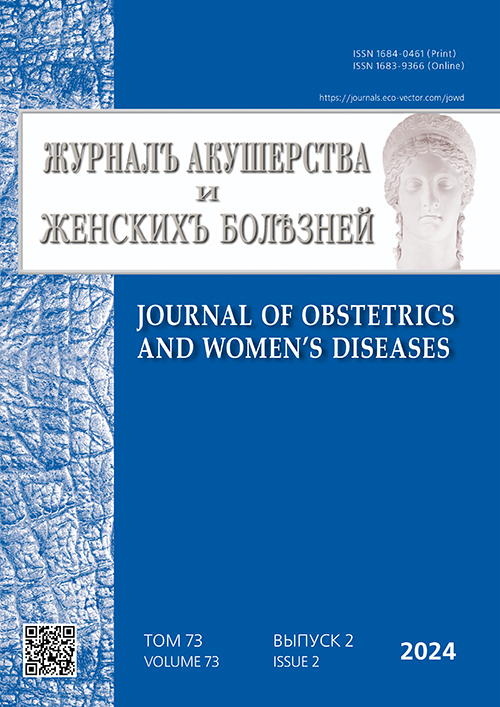Возможности применения метаболитов лактобацилл для лечения и профилактики бактериального вагиноза
- Авторы: Минакова А.Д.1, Джибладзе Т.А.1, Зуев В.М.1
-
Учреждения:
- Первый Московский государственный медицинский университет им. И.М. Сеченова (Сеченовский Университет)
- Выпуск: Том 73, № 2 (2024)
- Страницы: 149-154
- Раздел: Клинические рекомендации
- Статья получена: 04.02.2024
- Статья одобрена: 29.02.2024
- Статья опубликована: 27.05.2024
- URL: https://journals.eco-vector.com/jowd/article/view/626455
- DOI: https://doi.org/10.17816/JOWD626455
- ID: 626455
Цитировать
Полный текст
Аннотация
Одной из наиболее распространенных причин патологических выделений из половых путей у женщин репродуктивного возраста является бактериальный вагиноз. Помимо прочего он характеризуется высокой частотой рецидивов после стандартной антибактериальной терапии. На сегодняшний день проблемы профилактики и лечения бактериального вагиноза остаются актуальными и нерешенными. В статье изучен вопрос целесообразности применения метаболитов лактобацилл в лечении и профилактике бактериального вагиноза с учетом накопленных данных. Применение молочной кислоты в качестве дополнительного второго этапа лечения бактериального вагиноза может быть рассмотрено в качестве способа повышения эффективности терапии и приверженности пациентки к лечению, а также снижения вероятности рецидивов.
Ключевые слова
Полный текст
Об авторах
Алена Дмитриевна Минакова
Первый Московский государственный медицинский университет им. И.М. Сеченова (Сеченовский Университет)
Email: alenami1205@yandex.ru
ORCID iD: 0000-0002-5157-1888
SPIN-код: 6649-7776
аспирант
Россия, 119048, Москва, ул. Трубецкая, д. 8, стр. 2Теа Амирановна Джибладзе
Первый Московский государственный медицинский университет им. И.М. Сеченова (Сеченовский Университет)
Email: djiba@bk.ru
ORCID iD: 0000-0003-1540-5628
SPIN-код: 5688-1084
Scopus Author ID: 57194218506
доктор мед. наук, профессор
Россия, 119048, Москва, ул. Трубецкая, д. 8, стр. 2Владимир Михайлович Зуев
Первый Московский государственный медицинский университет им. И.М. Сеченова (Сеченовский Университет)
Автор, ответственный за переписку.
Email: vlzuev@bk.ru
ORCID iD: 0000-0001-8715-2020
SPIN-код: 2857-0309
Scopus Author ID: 7201884764
доктор мед. наук, профессор
Россия, 119048, Москва, ул. Трубецкая, д. 8, стр. 2Список литературы
- Kenyon C.R., Buyze J., Klebanoff M., et al. Association between bacterial vaginosis and partner concurrency: a longitudinal study // Sex Transm Infect. 2018. Vol. 94, N. 1. P. 75–77. doi: 10.1136/sextrans-2016-052652
- Brotman R.M., Klebanoff M.A., Nansel T.R., et al. A longitudinal study of vaginal douching and bacterial vaginosis – a marginal structural modeling analysis // Am J Epidemiol. 2008. Vol. 168, N. 2. P. 188–196. doi: 10.1093/aje/kwn103
- Madden T., Grentzer J.M., Secura G.M., et al. Risk of bacterial vaginosis in users of the intrauterine device: a longitudinal study // Sex Transm Dis. 2012. Vol. 39, N. 3. P. 217–222. doi: 10.1097/OLQ.0b013e31823e68fe
- Brotman R.M., He X., Gajer P., et al. Association between cigarette smoking and the vaginal microbiota: a pilot study // BMC Infect Dis. 2014. Vol. 14. P. 471. doi: 10.1186/1471-2334-14-471
- Boskey E.R., Cone R.A., Whaley K.J., et al. Origins of vaginal acidity: high D/L lactate ratio is consistent with bacteria being the primary source // Hum Reprod. 2001. Vol. 16, N. 9. P. 1809–1813. doi: 10.1093/humrep/16.9.1809
- Amabebe E., Anumba D.O.C. The vaginal microenvironment: the physiologic role of Lactobacilli // Front Med. 2018. Vol. 5. P. 181. doi: 10.3389/fmed.2018.00181
- Tyssen D., Wang Y.Y., Hayward J.A., et al. Anti-HIV-1 activity of lactic acid in human cervicovaginal fluid // mSphere. 2018. Vol. 3, N. 4. doi: 10.1128/mSphere.00055-18
- Conti C., Malacrino C., Mastromarino P. Inhibition of herpes simplex virus type 2 by vaginal lactobacilli // J Physiol Pharmacol. 2009. Vol. 60, N. 6. P. 19–26.
- Gong Z., Luna Y., Yu P., et al. Lactobacilli inactivate Chlamydia trachomatis through lactic acid but not H2O2 // PLoS One. 2014. Vol. 9, N. 9. doi: 10.1371/journal.pone.0107758
- Foschi C., Salvo M., Cevenini R., et al. Vaginal lactobacilli reduce neisseria gonorrhoeae viability through multiple strategies: an in vitro study // Front Cell Infect Microbiol. 2017. Vol. 7. P. 502. doi: 10.3389/fcimb.2017.00502
- Hearps A.C., Tyssen D., Srbinovski D., et al. Vaginal lactic acid elicits an anti-inflammatory response from human cervicovaginal epithelial cells and inhibits production of pro-inflammatory mediators associated with HIV acquisition // Mucosal Immunol. 2017. Vol. 10, N. 6. P. 1480–1490. doi: 10.1038/mi.2017.27
- O’Hanlon D.E., Moench T.R., Cone R.A. In vaginal fluid, bacteria associated with bacterial vaginosis can be suppressed with lactic acid but not hydrogen peroxide // BMC Infect Dis. 2011. Vol. 11. P. 200. doi: 10.1186/1471-2334-11-200
- Miko E., Barakonyi A. The role of hydrogen-peroxide (H2O2) produced by vaginal microbiota in female reproductive health // Antioxidants. 2023. Vol. 12, N. 5. P. 1055. doi: 10.3390/antiox12051055
- Chaithongwongwatthana S., Limpongsanurak S., Sitthi-Amorn C. Single hydrogen peroxide vaginal douching versus single-dose oral metronidazole for the treatment of bacterial vaginosis: a randomized controlled trial // J Med Assoc Thai. 2003. Vol. 86, N. 2. P. S379–S384.
- Ross J.D.C., Brittain C., Anstey Watkins J., et al. Intravaginal lactic acid gel versus oral metronidazole for treating women with recurrent bacterial vaginosis: the VITA randomised controlled trial // BMC Womens Health. 2023. Vol. 23, N. 1. P. 241. doi: 10.1186/s12905-023-02303-5
- Mendling W., Shazly M.A.E., Zhang L. The role of lactic acid in the management of bacterial vaginosis: a systematic literature review // Future Pharmacology. 2022. Vol. 2, N. 3. P. 198–213. doi: 10.3390/futurepharmacol2030014
Дополнительные файлы







